150 Years of International Harvester Online Read
 | |
| Industry | Agricultural, Automotive |
|---|---|
| Predecessor | McCormick Harvesting Machine Company Deering Harvester Company Warder, Bushnell, and Glessner etc. |
| Founded | March 22, 1902 (1902-03-22) |
| Founders |
|
| Defunct | 1985 (1985) |
| Fate | Renamed as Navistar International Corporation |
| Successor | Navistar International |
| Headquarters | Chicago, Illinois, U.S. |
| Expanse served | Worldwide |
| Products |
|
The International Harvester Company (often abbreviated past IHC or IH, or only International (colloq.)) was an American manufacturer of agricultural and construction equipment, automobiles, commercial trucks, backyard and garden products, household equipment, and more. It was formed from the 1902 merger of McCormick Harvesting Machine Visitor and Deering Harvester Visitor and three smaller articles: Milwaukee; Plano; and Warder, Bushnell, and Glessner (manufacturers of Champion brand). In the 1980s all divisions were sold off except for International Trucks, which changed its parent company name to Navistar International (NYSE: NAV). Its brands included McCormick, Deering, and afterward McCormick-Deering, as well every bit International. Along with the Farmall and Cub Cadet tractors, International was also known for the Spotter and Travelall vehicle nameplates.

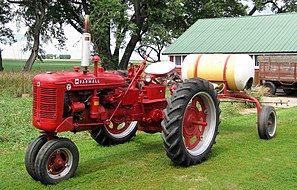
A 1954 IH Farmall Super C
Given its awe-inspiring importance to the edifice of rural communities the brand continues to accept a massive cult post-obit. The International Harvester legacy non-profits host some of the largest agriculture related events in the U.s.a..
Post-obit years of financial and economic decline, International began selling its separate equipment divisions, starting with the sale of the construction division to Dresser Industries in 1982. In Nov 1984 IH finalized a deal with Tenneco to sell the farm equipment division to Tenneco'due south subsidiary Case Corporation, and the make continues every bit Case IH which is owned past Fiat. The European division exists today as McCormick Tractors and is endemic by ARGO SpA of Italia. International became solely a truck and engine manufacturer and reorganized as Navistar International in 1986. Throughout its existence International Harvester was headquartered in Chicago, Illinois. In 2020 Volkswagen agreed to fully purchase the remaining shares of Navistar.
History [edit]
Founding [edit]

The roots of International Harvester run to the 1830s, when Virginia inventor Cyrus Hall McCormick perfected his version of a equus caballus-fatigued reaper, which he field-demonstrated in 1831 and for which he received a patent in 1834. Together with his brother Leander J. McCormick, he moved to Chicago in 1847 to exist closer to the Midwestern grain fields and founded the McCormick Harvesting Car Company. The reaper sold well, partially as a effect of savvy and innovative business practices. Their products came onto the market just as the development of railroads offered wide distribution to distant territories. He developed a vast support network to demonstrate field operations. McCormick died in 1884 and his company passed to his son, Cyrus McCormick, Jr., whose antipathy and incompetence toward organized labor sparked the Haymarket matter, the origin of May Day as a labor holiday. In 1902, the McCormick Harvesting Machine Company and Deering Harvester Company, along with three smaller agricultural equipment firms (Milwaukee Harvesting Machine Co., Plano Manufacturing Co., and Warder, Bushnell, and Glessner—manufacturers of Champion brand) merged to create the International Harvester Company.[1] Banker J.P. Morgan provided the financing.[ii] The new company was valued at $150 million.[1] In 1919, IH bought the Parlin and Orendorff manufactory in County, Illinois, a leader in turn manufacturing, renaming it County Works.

Ad for the 1940 International Tanker Truck
Sustained success [edit]

1939 advertisement for the International "Jungle Yacht" tractor-trailer, for Attilio Gatti'south luxury scientific expedition in the Belgian Congo[3]
In 1926, IH's Farmall Works built a new found in Stone Island, Illinois. By 1930, the 100,000th Farmall was produced. IH next set their sights on introducing a truthful 'general-purpose' tractor to satisfy the needs of the average American family farmer. The resulting 'letter' series of Raymond Loewy-designed Farmall tractors in 1939 proved a huge success. IH dominated the market through the 1950s despite strong competition from Ford, Allis Chalmers, Massey Ferguson and John Deere.[ commendation needed ]
IH ranked 33rd amid Us corporations in the value of Globe War Ii production contracts.[four] In 1946 IH acquired a defense plant in Louisville, Kentucky, which was adapted for production of the Farmall A, B, and the new 340 tractors. Information technology acquired the Metropolitan Trunk Company of Bridgeport, Connecticut, in 1948.[5] The commercially successful Metro line of forrad command vans and trucks were produced hither from 1938 until 1964.[ commendation needed ]
In 1970, Pacific Trucks was purchased.[6] In 1974, the five-millionth IHC tractor was produced at the Stone Isle Farmall plant.[ commendation needed ]
Throughout the 1960s and 1970s, despite good sales, IH's profit margins remained slim. The continual addition of unrelated business organization lines created a somewhat unwieldy corporate organization. Overly conservative direction and a rigid policy of in-business firm promotion tended to stifle new direction strategies and technical innovation. IH faced strong competition and increased production costs, primarily due to labor and government-imposed environmental and condom regulations. In 1974 the 5 millionth International Harvester tractor, a 1066, was manufactured.[vii]
Downfall [edit]
In 1979 IH named a new CEO, Archie McCardell, who was determined to better profit margins and drastically cut costs. Unprofitable lines were terminated and factory production was concise. By the end of the yr, profits were at their highest levels in x years just cash reserves were still low. Union members became increasingly irate over these measures and in the spring of 1979, IH prepared to face a strike. On November ane, IH announced McCardell had received a $1.8 meg bonus. After he pressed for more than concessions from the United Auto Workers, a strike was called on Nov 2, 1979.[8] By the time it ended, the strike had cost the company virtually $600 million (over $two billion today).[9]
By 1981, the company'southward finances were at their everyman point e'er. The company sold its Payline division of construction equipment to Dresser Industries in 1982. Farther assets were sold to Tenneco, Inc., in 1984.
Following the merger, tractor product at Farmall Works ceased in 1985. Production of the new Case IH tractors moved to J.I. Case in Racine, Wisconsin. Product of IH Axial-Flow combines continued at the Due east Moline, Illinois, mill. The Memphis Works plant was closed.[ citation needed ] The truck and engine divisions remained and in 1986, Harvester changed the corporate proper name to Navistar International Corporation, having sold the International Harvester name to Tenneco. Navistar International Corporation continues to industry medium- and heavy-duty trucks, school buses, and engines under the International brand name.[9]
Divisions and products [edit]
Agriculture Division [edit]

McCormick-Deering 15–30 on the fields of the Ukrainian SSR in 1930
The International Harvester Agricultural Division may accept been second to the Truck Partitioning only it was the best-known subsidiary. One of its early products was the Traction Truck, a frame manufactured by Morton Traction Truck Company (later bought past IHC) featuring an IHC engine.
From 1902 to the early 1920s, the McCormick and Deering dealerships kept their original branding with Mogul tractors sold by McCormick and Titan tractors at Deering due to the still-present competitiveness of the old rivals.

An International Harvester Blazon A tractor, manufactured from 1908 to 1913
The early tractors [edit]
IH produced a range of large gasoline-powered subcontract tractors nether the Mogul and Titan brands. Sold by McCormick dealers, the Type C Mogul was footling more than a stationary engine on a tractor chassis, fitted with friction bulldoze (one speed forrard, one contrary).[10] Between 1911 and 1914, 862 were built.[ten] These tractors had varied success just the trend going into the mid-1910s was toward "small" and "inexpensive".
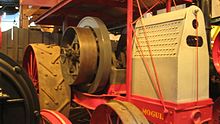
A 1911 one-cylinder 25 hp (19 kW) Type C Mogul
The company's first important tractors were the 10-20 and 15-30 models. Introduced in 1915, they were primarily used as traction engines to pull plows and for belt work on threshing machines. The x-twenty and 15-30 had like Mogul and Titan versions.
Concurrently, IHC purchased a number of smaller competitors. Parlin & Orendorff (P&O Plough) and Chattanooga Turn were purchased in 1919. Other make names they incorporated include Keystone, D.Chiliad. Osborne, Kemp, Meadows, Sterling, Weber, Plano, and Champion.
In 1924 IH introduced the Farmall, a smaller full general-purpose tractor, to fend off competition from Ford Motor Visitor's Fordson tractors. Farmall was a leader in the emerging row-crop tractor segment.

Following the introduction of Farmall, several similarly styled "F Series" models were introduced while the original design continued to be produced every bit the "Regular."
In 1932, IH produced their first diesel engine for the McCormick-Deering TD-twoscore crawler. This engine would outset on gasoline and and then switch to diesel. Other diesel engines of this era were difficult to start in cold weather and using gasoline allowed the engine to thoroughly warm up first. In 1935, it was used in the WD-forty, condign the first diesel tractor on wheels in North America[12] (the world'south first diesel tractor was Germany'south Benz-Sendling BS 6 in 1922).

A 1954 R-110 serial pickup
Heavy tractors [edit]
The market for industrial tractors grew in the 1930s. The TD-40, the beginning of IH's heavy-equipment crawlers, was suited for a wide range of environments. As need for construction equipment grew, so did the contest. The diversification of the agronomical tractor range into genuine structure equipment whetted appetites for further expansion. In 1937 IH engaged designer Raymond Loewy to revamp its product line and logo. In 1938 the first such model was the TD-65 heavy tractor, subsequently renamed the TD-18.[13]
The letter of the alphabet and standard series [edit]

For model twelvemonth 1939, Loewy created the Farmall "letter series" (A, B, BN, C, H, and M) and the McCormick-Deering "standard serial" (W-four, W-6, and Westward-9).[14] For 1941 the Physician model was introduced equally the starting time row crop diesel-powered tractor; over a decade later, IH's largest competitor, John Deere, introduced a diesel pick on their row crop models. The letter series tractors were updated to the "super" series in 1953 (with the exception of the A, which had become a "super" in 1947, and the B and BN, which were discontinued in 1948). Many of these tractors (especially the largest, the H, Grand, and Due west models) are however in operation on farms today. Peculiarly desirable are the diesel fuel-powered Md, WD-six, and WD-ix'south. These tractors carried forrad the gasoline-starting diesel fuel concept of the WD-40.
The letter of the alphabet and standard series of tractors was produced until 1954 and was a defining product in IH history.
In 1947, the smallest tractor in the Farmall line was introduced, the Cub. With a threescore-cu. in., four-cylinder engine and a 69-inch wheelbase, the Cub was aimed at pocket-sized farms which had previously relied on horse-drawn equipment. Similar the diverse John Deere L/LA/LI models, i of the "mechanization-resistant" markets it hoped to penetrate was the small ane-mule family farms of the rural American Deep Southward, but the Cub besides sold to owners of larger farms needing a second tractor. Production of the Cub commenced at the newly acquired and updated Farmall Works-Louisville plant (formerly the wartime Curtiss-Wright Shipping factory in Louisville, Kentucky). Selling for $545 in 1947, the Cub proved extremely popular and its design connected largely unchanged until 1979.
For 1955 in IH tractors, the numbered "hundred series" was offered. Although given slightly different styling and few new features, they were withal updates to the models introduced in 1939. The just new tractor in the 1955 lineup was the 300 Utility. In 1957 power was increased in some models and the 230 Utility was introduced. This improved sales merely the company's aversion to change was already showing.[xv]
Heavy tractors: the 1950s [edit]
IH would sell 38,000 TD-18 series tractors between 1938 and 1958. The TD-18 would be replaced past an upgraded TD-18A in 1949 and 181/182 variants in 1955. In 1958 the TD-twenty crawler was introduced.[16]
60 Series call back [edit]
In July 1958, IH launched a major campaign to innovate a new line of tractors, the 60 series. At the Hinsdale, Illinois, Testing Farm, IH entertained over 12,000 dealers from over 25 countries. The series included the first-of-its-kind six-cylinder 460 and 560 tractors. Unfortunately just a year later on, these models were recalled due to final drive component failures. They had not been updated since 1939 and would neglect rapidly under the stress of the more powerful threescore-series engines. Some customers lost faith in IH and migrated to John Deere'due south New Generation of Ability tractors introduced in 1960.
1960s [edit]

The originally British-built International B275 model still in product in India and built by Mahindra and Mahindra
Throughout the 1960s, IH introduced new tractors and new sales techniques. As producing tractors was the lifeblood of the company, IH would have to remain competitive in this field. They both succeeded and failed at this goal but farming was virtually to change. In 1963, IH introduced the 73 hp (54 kW) 706 and 95 hp (71 kW) 806 tractors. In 1964, IH made its four-millionth tractor, an 806. In 1965, IH introduced its first 100 hp (75 kW) 2-wheel-bulldoze tractor, the 1206. Another option became available in 1965 for the 706, 806, and the new 1206: a manufacturing plant-installed cab (made past Stopler Allen Co.), often chosen the "water ice cream box" due to its shape. Information technology could be equipped with a fan and heater. Past 1967, over 100,000 models 706, 806, and 1206 were built. The 276 was besides built at this time, condign popular for smaller farms with tighter lanes and fields due to its lighter weight.
In 1967 was the introduction of the bigger and more than powerful 56 series tractors equally replacements for the popular "06" serial. These new models included the 65 hp (48 kW) 656, 76 hp (57 kW) 756, the 101 hp (75 kW) 856, and the 116 hp (87 kW) 1256. The "ice cream box" cab was still an choice. In 1969 IH introduced the 1456 Turbo at 131 hp (98 kW). Also that year, the 91 hp (68 kW) 826 was introduced with the option of gearshift or hydrostatic transmissions. The "water ice cream box" cab was dropped and replaced with a new "custom" cab fabricated by Exel Industries which could exist equipped with factory ac, heat, and an AM radio. Another milestone was the 1970 introduction of the 1026 Hydro, basically a hydrostatic version of the 1256 and at that time the nigh powerful hydrostatic transmission tractor made in the US with 114 hp (85 kW).
1970s [edit]
In 1971, IH introduced the 66 series line. The new models included the 85 hp (63 kW) 766, the 101 hp (75 kW) 966, the 125 hp (93 kW) 1066 turbo, the 145 hp (108 kW) 1466 Turbo, and the 145 hp (108 kW) 1468 Five-8. The 130 hp (97 kW) 4166 4WD was too introduced. The 966 and 1066 were bachelor with Hydro or gearshift transmissions and the choice of ii-post roll over protection structures (ROPs) or 2 unlike cabs, the "custom" and the "deluxe". Both could be equipped with air conditioning, heat, and AM-FM radios.
In 1972, the 666 replaced the long-running 656, the 150 hp (110 kW) 1568 V-8 replaced the 1468, and the 160 hp (120 kW) 1566 and the 163 hp (122 kW) 4366 4WD were introduced. Also later that yr, 4-mail ROPs replaced two-mail; the "custom" cab was dropped and the "deluxe" cab was now painted red instead of white. Due to horsepower confusions, the 966 and 1066 Hydro models were restriped; the Hydro 100 and the 666 Hydro became the Hydro lxx. On February i, 1974, at 9:00 am, the 5-millionth tractor came off the assembly line at the Farmall Establish in Illinois. IH was the commencement tractor manufacturer to accomplish this.[15] Too in 1973, IH officially dropped the "Farmall" name from its tractor. This ended an era that began with the first Farmall "Regular" dorsum in 1924.
The 230 hp (170 kW) 4568 Five-viii 4WD was introduced in 1975. In 1976, the entire tractor line got a new pigment chore and decal blueprint. No longer were the side panels all white with chrome and blackness decals: they were now all red with a black-striped sticker. This was washed to articulate inventory for the forthcoming Pro Ag Line.
In September 1976, IH released their 86 serial Pro Ag Line. The models included the 80 hp (60 kW) 786, the 90 hp (67 kW) 886, the 101 hp (75 kW) 986, the 104 hp (78 kW) 186 Hydro, the 135 hp (101 kW) 1086, the 146 hp (109 kW) 1486 and the 161 hp (120 kW) 1586. These new tractors had a new cab dubbed the Control Center that came standard with air conditioning, heat, and several radio-CB options. The driver sat well ahead of the rear axle and the fuel tank was mounted behind the cab over the rear axle. This increased balance and ride. As well in 1976, the 62 hp (46 kW) 686 along with the "86" series iv-wheel-drives were introduced, including the 4186, 4386, 4586, and 4786.
In 1977, International Harvester introduced the first Axial-Menstruum rotary combine. This machine, produced at East Moline, Illinois, was the kickoff generation of over thirty years of Axial-Flow combines.
In 1979, IH introduced two all-new tractors: the 3388 and 3588, known as the two+ii 4WD line. These tractors were the result of taking 2 1086 rear ends and hooking them together with a transfer case. A year after, the 3788 was introduced. Although these tractors performed well in the field, they never sold well.
1980s [edit]
Every bit the 1980s began, IH faced a stable economy, even so an unknown fate. In September 1981, IH announced at a dealership meeting the new "50 Series" of tractors, which included the 136 hp (101 kW) 5088, the 162 hp (121 kW) 5288 and the 187 hp (139 kW) 5488. IH also released the "30 series", which included the 81 hp (60 kW) 3088, the 90 hp (67 kW) 3288, the 112 hp (84 kW) 3488 Hydro, and the 113 hp (84 kW) 3688. These new tractors proved in one case once more that IH was innovative. Designed and styled by IH industrial designer Gregg Montgomery (Montgomery Blueprint International), the new stylish design of the 50 and thirty series changed the look of tractors from that fourth dimension forward. IH spent over $29 one thousand thousand to develop this new series, and the event was the last great lineup of tractors from International Harvester.
Many engineering-related innovations were used in the new series. A computer monitoring system (Sentry) was developed, and IH became the offset manufacturer to add a computer to a farm tractor. Other innovations included a "Z" shift pattern, an 18-speed synchronized manual, a forrad air-flow cooling system which sucked air from to a higher place the hood and blew it out the front grille, "Power Priority" three-pump hydraulic arrangement, color-coded hydraulic lines and controls, and a new rear-hitch arrangement. The l Series had an unprecedented three-year or 2,500-hour engine and drive-train warranty, which later became an manufacture standard. Although no new sales records were set, IH sold a respectable number of these tractors during their short production time. IH also released the "60 series 2+2s" and planned on making the "Super 70 series" 2+2s, but merely a handful of these exist today. On May fourteen, 1985, the final IH tractor rolled off the manufactory line, a 5488 FWA.
In the late 1970s, IH entered a deal with Spain's Enasa to build diesel engines there as Internacional de Motores. Later on a downturn in the market place coupled to problems with Espana'due south entry into the European Economic Customs threatened the profitability of this project, International Harvester withdrew in 1982.[17] In render for existence immune to escape all conditions of the joint venture, IH lost their up-forepart investment in the engine found and ended up selling British truck manufacturer Seddon Atkinson (which had belonged to IH since 1974) to Enasa in 1983.
Make names of the agriculture division [edit]

McCormick Deering tractor
IH over the years used a number of brand names to market their tractor and harvesting products:
- International (1902–1985)
- Titan (1910–1924)
- Mogul (1911–1924)
- McCormick–Deering (1922–1947)
- McCormick (1947–1958)
- Farmall (1924–1973)
- Fairway (1924–1938)
- Electrall (1954–1956)
- Cub (1947-1985)
Other agricultural products [edit]
Along with the prominent tractor partitioning, IH also sold several different types of farm-related equipment, such equally balers, cultivators, combines (self-propelled and pull behind), combine heads, corn shellers, cotton wool pickers, manure spreaders, hay rakes, crop dusters, disk harrows, elevators, feed grinders, hammer mills, hay conditioners, milking machines, planters, mills, discs, plows, and miscellaneous equipment.[xviii]
Also produced were twine, stationary engines and wagons.[xviii]
Earthmoving segmentation [edit]
IH built upwardly its earthmoving division over a period of time, buying companies and acquiring engineering science. Its heavy tractor range was an established offering, nevertheless IH wanted to offering innovative new structure technology. Significant moves included the purchase of the Frank 1000 Hough company [19] which produced an iconic car chosen a PayLoader,[xx] and the purchase of French company Yumbo, which produced hydraulic excavators.[21]
Betwixt 1956 and 1982 IH adult and sold a range of off-route dump trucks, which were known commercially as 'PayHaulers'.
International manufactured and sold an all-encompassing range of heavy equipment. In 1974 IH renamed this division the 'Payline' division.
Payloaders [edit]
The original payloader model was literally a tractor which had forks welded to the front. Frank Hough was the man who invented the concept and Hough's company worked closely with IH until it was purchased in 1952. The terminology came to hateful whatever type of forepart loader auto, and loaders were manufactured in a number of varieties, included wheeled and track loaders, rear wheel loaders or an articulated steering design.[19]
PayScrapers [edit]
In the early 1950s contractors worldwide began using motor scrapers as a means of shifting clay. IH had a hole in its product range; information technology did not offering a motor scraper product to the market. Ane of IH'due south suppliers, a company named Heil Earthmovers, manufactured a range of scrapers called 'Heiliners.'[22]
Rather than spend money on R&D and enter the market at a later date, in 1953 IH bought Heil's road machinery division, incorporating a range of motor and towed scrapers.[23]
Attachments: blades, buckets, rippers and compaction equipment [edit]
IH International had a supply agreement for its heavy tractor attachments with a visitor called Bucyrus-Erie. Among a multifariousness of attachment solutions Bucyrus-Erie made a range of cable and hydraulically operated blades which fitted International-Harvester rails type tractors.
IH purchased the blades range from Bucyrus-Erie in the 1950s and captivated these into its machinery division.[24]
IH likewise purchased attachments for the tractor range from Isaacson, including logging arches and dozer blades.[25] Carrying on with its expansion IH purchased Isaacson's attachments sectionalisation in 1952.[24]
Electrall [edit]
The Electrall system was introduced in 1954; it was a short-lived attempt to market electrically operated farm equipment and accessories. The system, co-developed with Full general Electrical, consisted of a 208 5 three-phase alternating-electric current generator connected with electric cables to the device to exist powered. The generator could even power a household. A 10 kW Electrall generator was an selection on the Farmall 400 tractor,[26] and a 12.5 kW PTO-driven version was made. The possible applications of Electrall power were many, but few fabricated it to market. IH marketing materials showed a haybaler existence Electrall powered. One of the more than novel applications of the Electrall was a device to assassinate insects in the field at nighttime (basically like a modern-24-hour interval issues zapper, just on a larger scale).[27]
Road vehicles [edit]
Calorie-free duty trucks [edit]
IH is ofttimes remembered equally a maker of relatively successful and innovative "light" lines of vehicles, competing straight against the Big Three. The most mutual were pickup trucks. IH made light trucks from 1907 to 1975, beginning with the Model A Motorcar Wagon (sometimes called the "Car Buggy").[28] Production commenced in Feb 1907 at IH'due south McCormick Works in Chicago, although production was moved to Akron, Ohio, in October that year.[28] Powered by a horizontally opposed, air-cooled twin around 15 hp (11 kW), it was a correct-hand-bulldoze model popular in rural areas for loftier ground clearance on the poor roads typical of the era. It featured a rear seat convertible to a carrier bed.[29] The Auto Wagon was renamed the Motor Truck in 1910, and was a precursor to the successful modern pickup truck. They were chosen IHC until 1914, when the 'International' name was offset practical.[28] The final light line truck was made on May 5, 1975.
Following the early on success with the Auto Buggy, International released their G and KB series trucks in the mid-1940s. They were more simplistic than other trucks released in that era. This was followed by the L Series in 1949, which was replaced by the R Series in 1952, followed by the S line (a name re-used later for IH'south larger medium-duty trucks) in 1955. In 1957, to celebrate IH's gold anniversary as a truck manufacturer, this was replaced by the new A line. 'A' stands for ceremony. With low-cal modifications to its advent, but more serious changes under the shell (and a number of new names), this blueprint connected in product until replaced by the 1100D in tardily 1969, which looked very similar to the Scout which was already in production.[30]
Corresponding with the truck "letter lines" was the Metro line of step (delivery) vans. Starting in 1938 and manufactured through 1975, the Metro serial was produced and updated with each iteration of IH's truck lines. Too, special-apply variants were sold, such equally the Metro Coach (a bus version with windows and passenger seats) and Metro front-end section and chassis for total commercial customization. Additional variants were based on the medium-duty engine and chassis lines.[31]
IH abandoned sales of passenger vehicles in 1980 to concentrate on commercial trucks and school buses.
The Scout and Calorie-free Truck parts business was sold to Sentinel/Light Line Distributors, Inc. in 1991.
-
-

-

-
1954 R-110 serial pickup
-

-

1965 International D1000 Travelette 4x4
-

1975 International 150
Sport-utility vehicles [edit]
One of the company's light-duty vehicles was the Travelall, which was like in concept to the Chevrolet Suburban. The Travelette was a crew cab, bachelor in 2- or four-wheel drive. A three-door version was bachelor starting in 1957, and a 4-door version was available starting in 1961. The 1961 Travelette four-door (crewcab) was the first half-dozen-rider, 4-door truck of its time.
The Lookout man, first introduced in 1961,[28] is a pocket-size, two-door SUV, similar to a Jeep. In 1972, the Lookout became the Scout II, and in 1974, Dana 44 axles, power steering, and ability disc brakes became standard. Afterwards the Light Line pickups and Travelall were discontinued in 1975, the Scout Traveler and Terra became bachelor, both with a longer wheelbase than a standard Scout 2.
-
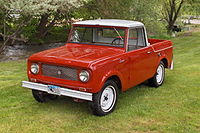
1961 International Scout
-

1973 International Watch
-
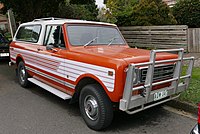
1979 International Watch II
-

1968 International Travelall 1100C
-

1975 International Travelall Custom 150
Motorhomes [edit]
In the 1970s, motorhomes were manufactured using IHC engines and bare chassis.[ citation needed ] About of the bodies were constructed of fiberglass.[ citation needed ]
Commercial trucks (Truck and Engine Division) [edit]
International Harvester was an early manufacturer of medium- and heavy-duty trucks. Although based upon truck chassis, IH besides became the leading manufacturer of the chassis portion of body-on-chassis conventional (type C) school buses. In 1962, IH offered the International Harvester Loadstar which became the premier medium-duty truck. In 1978, IH offered the International Harvester South-Series, which replaced the Loadstar in 1979.
With the truck and engine divisions remaining following the 1985 auction of the agricultural division, International Harvester Company changed their corporate name to Navistar International in 1986. Today, Navistar International's subsidiary, International Truck and Engine Corporation, manufactures and markets trucks and engines under the International brand name. From 1983 to 2010, Ford Motor Company offered International V8 diesel fuel engines in heavy-duty pickup trucks, vans, and SUVs (using the Power Stroke proper noun later 1994).
1960s [edit]
In 1961, the DCO-400 "Emeryville" model line was expanded with a conventional; officially named the D-400, the model line shared its cab with the COE and was the first International conventional produced with a tilting hood.[32]
In 1962, International began to phase out the R-line series of trucks (dating to 1953). In place of a comprehensive model line ranging from half-ton pickup trucks to its largest Form 8 trucks, International introduced two purpose-built model lines for commercial use. Slotted above its Light Line pickup trucks, the Loadstar was a medium-duty conventional-cab truck.[33] [34] For 1963, International introduced the heavier-duty Fleetstar,[35] a short-hood conventional slotted between the Loadstar and the heavier-duty R and V-Line conventionals. While no longer serving as a comprehensive model range, the Loadstar shared its cab with the A-series pickup truck (and its derivatives); equally a cowled chassis, the Loadstar was produced for bus utilise (the IHC Schoolmaster). Sharing simply its name with its conventional-cab namesake, the Loadstar CO was a low-cab COE (with a forrard-tilting cab).
In 1965, International introduced the CO-4000, the first heavy-duty COE designed entirely by the company, replacing the DCO-400 "Emeryville" COE (which sourced its cab blueprint from Diamond T).[34] In a design feature that would be adopted past International COEs into the 1990s, the cab was designed with a big trapezoidal grille.
In 1968, International redesigned the Fleetstar, adopting the cab of the Calorie-free Line pickups. Renamed the Fleetstar-A, the redesign marked the consolidation of the Fleetstar with the previous R-line and V-line trucks.[35] The largest R-210 and R-230 remained (dropping their R prefix) aslope the newly introduced K-serial as the largest International trucks, sharing a common cab (dating dorsum to 1952).[34] The Transtar proper name made its first appearance, as the CO-4000 was replaced past the Transtar CO4070/4090; while visually similar to its predecessor, the Transtar CO was designed with an all-new cab (to arrange larger diesel engines).[34]
For 1969, International introduced the last version of the Emeryville model line, with the DC-400 Transtar 400 replacing the D-400.
-

Tardily 1960s-early 1970s Loadstar 1700
-
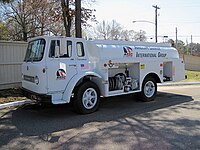
1960s Loadstar CO1700
-

1960-1971 210 in service equally tow truck (consign)
-

1969-1971 Transtar 400 (consign)
-

1965-1968 CO-4000 COE
1970s [edit]
In 1970, International split the CO Loadstar into its own production line, dubbed the Cargostar. As office of a model update, the Cargostar received a larger grille and wider cab over its predecessor. Competing straight confronting the Ford C-Series, the Cargostar was a medium-duty truck fitted with both gasoline and diesel engines (shared with the Loadstar conventional).
1971 marked the cease of the "Emeryville" product lines, as the DC-400 Transtar 400 was replaced by the Transtar 4200/4300. Developed equally a Course 8 highway tractor, the Transtar 4200/4300 introduced an all-new cab that would exist used for International heavy-duty trucks through 1999. Competing against a broad range of manufacturers, the Transtar conventional was offered in both short and long-hood configurations for both regional and long-distance shipping.
In 1972, the Paystar 5000 series was introduced, replacing the 210/230 and Thou-serial trucks (dating to 1952). Developed for severe-service use (primarily construction and related applications), the Paystar shared its cab with the Transtar, using a heavier-duty chassis, steel fenders, and a flat-panel hood.[34] The medium-duty Loadstar received an optional tilting hood with a larger grille and straighter-border fenders (updating its appearance for the first time in 10 years).
In 1974, the Transtar Ii COE was introduced, following a redesign of the Transtar.[34] Distinguished past acme-mounted windshield wipers, the Transtar Two standardized the previous raised-cab option, as the previous 852 cubic-inch Detroit Diesel fuel 12V71 V12 was replaced by some of the largest-displacement engines e'er fitted to a route-going vehicle, including the Cummins KTA diesel fuel I6 (1,150 cubic inches) and the Caterpillar 3408 diesel fuel V8 (one,099 cubic inches). On the other end of the size scale, the Cargostar underwent a 2nd update, with a slightly wider cab and a much larger grille (sharing the black trim band of the Transtar COE grille).
For 1976, International launched its "Eagle" flagship brand, used into the 2010s.
In 1977, the International Southward-series was introduced, consolidating the Fleetstar and Loadstar into a unmarried model range.[36] While less comprehensive than the product ranges of the 1930s to the 1950s, the S-series product line included medium-duty, heavy-duty, severe-service, and highway trucks (along with a new generation of the Schoolmaster bus chassis) from the Class 5 to Grade eight size ranges. At its 1977 launch, the Due south-series was introduced to replace the Fleetstar, with lighter-duty models phased in to supercede the Loadstar during 1979.[34] Competing confronting an extensive segment of the truck industry, the S-Series was produced in multiple layouts, hood lengths, and axle configurations; gasoline and diesel engines were offered.[34] [37]
Produced every bit a cowled chassis (Schoolmaster), straight truck, or semitractor, the S-Serial was produced from 1977 to 2004, remaining the longest-produced vehicle line always produced by International (as either International Harvester or Navistar).
-
1970-1973 Cargostar
-

Late 1970s Paystar 5000 (export)
-

1974-1980 Transtar II COE
1980s [edit]
In 1981, International introduced the CO9670, replacing the Transtar II. Sharing only the trapezoidal grille with the previous Transtar Ii, the CO9670 was designed with a larger cab with improved visibility and improved admission (larger windshield, shared doors with the Transtar/Paystar conventional); to increment fuel economy, the Cummins KTA diesel was replaced by a turbocharged Cummins N-serial I6.[34]
For 1985, the Transtar conventional was reintroduced, becoming the International 9000 series; while the short-hood Transtar was discontinued (overlapped by the S2200 and S2300 Class 8 tractors), the long-hood 4300 was renamed the International 9370. Sharing its cab with the Transtar, the 9370 was restyled with a larger grille and vertically stacked quad headlamps.
After seeing almost no alter since 1974, International concluded product of the Cargostar (the final Loadstar-based truck). As the company did non develop a tilt-cab truck derived from the S-series (or a distinct vehicle), International introduced the 400/500/700/900 low-cab COE, produced past Nissan Diesel fuel (UD). The first imported vehicle marketed by the company, the 400-900 was marketed through 1991.
-

Early 1980s S1900 dump truck
-

1984 International CO9670
-
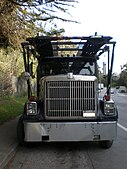
1985-1988 9370 Eagle (front view)
Overseas subsidiaries [edit]
Australia [edit]

1953 International Utility
Australian Army designs [edit]
International Harvester Australia, a subsidiary of the US manufacturer, had a long relationship with the Australian Ground forces with the US-designed As series trucks in the early on 1950s. The AS164 4x2 used as a tractor unit[38] and the 4x2 AS161 used as a trayback troop send[39]
The clan betwixt International Harvester Australia and the Australian Army adult and in conjunction with the Army Design Institution of the Australian Republic Department of Supply, designed and constructed a range of trucks for the Australian Army. With the body loosely based upon the design of cab 13 of the Canadian Armed forces Pattern truck, the commencement prototype congenital in 1959 was the International Truck Cargo 2+ one⁄2 Ton General Service, Australian No.ane Mk1.[40] which was followed by the Mk2 paradigm. A variant with a midmounted, 20,000-lb winch, resulted in the commencement production model,[41] the Mk3 inbound service in 1963 – just in fourth dimension for Australia's entry into the Vietnam War.
A five-ton 6×vi version was to follow with three major variants the Truck Cargo 5 Ton with winch F1[42] which replaced the Mk3 in Vietnam service.
The F2 a tipper version[43] that replaced the International Harvester AB160 "teaspoon Tipper"[44] in both Vietnam and Borneo theatres of operations.
The F5 wrecker[45] with a lack of iv×iv 2+ one⁄2 ton trucks bachelor because of the Vietnam War, the Mk3 was supplemented with further iv×4 production with the updated Mk4 version[46] which shared the cab with the 6×6 variants Production of The Australian No.1. range of trucks were produced until 1973. The Mk3, Mk4, F1, F2 and F5 saw service until the late 1980s.[47] [48]
ACCO [edit]
The Australian designed and built International Australian A-line Cab Over (AACO) was first produced in the late 1960s and later in 1972 the Australian C-line Cab Over (ACCO) . The ACCO is a cab over engine type truck and has been offered in 4x2, 4x4, 6x2, 6x4, 8x4, and 10x4 configurations. Engines used take been Cummins, Caterpillar, Detroit Diesel, Perkins, Neuss or GMC with Road-Ranger or Allison transmissions and Rockwell differentials. The ACCO range were built to order, serving private operators, burn down departments, armed services services, and municipal departments beyond Australia and New Zealand. The ACCO became the about pop product of International Harvester in Australia. The ACCO was discontinued in November 2019 and replaced past a locally built European designed ACCO, under the buying of Iveco.[49]
-

International ACCO
-

NZFS 1969 C1800 Butterbox ACCO
Brazilian subsidiary [edit]
International Harvester Máquinas South.A. was established with Brazilian government back up as part of a project to develop a vehicle manufacture there. Their first production was the International S-184 heavy truck.[l] In 1966 Chrysler purchased International's Brazilian constitute.[51]
Home products [edit]
Domicile appliances [edit]
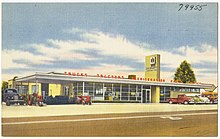
Postcard of an IH dealer in Texas, showing trucks, tractors and refrigeration equipment
Although best known for farm equipment, IH produced home appliances for farmers and nonfarmers akin. This included refrigeration equipment such as refrigerators, air conditioners, and freezers. IH had a refrigeration division of its own, as did other vehicle manufacturers of the time: Ford had Philco, Chrysler had Airtemp, General Motors had Frigidaire, Nash-Kelvinator Corporation (and then American Motors) had Kelvinator, Studebaker had the Franklin Appliance Company, and Crosley had Crosley.
The IH apparatus division had originally been developed to manufacture commercial-class items to farmers, nearly of whom had but received electricity by way of the many electrification projects in the U.S. earlier and later World War Two. Amid the offerings were milk coolers and walk-in freezers for produce and meat. Later on, IH courted the farmer's wife with kitchen refrigerators bachelor in the latest designer styles. The IH spokeswoman for these products was Irma Harding, a factory trademark. These products were introduced in 1947 and sold for less than x years. The refrigeration division was sold to Whirlpool Corporation in 1955. Since the duration of product was short, IH appliances are rare today.[eighteen] [52]
On the American sitcom Friends, the refrigerator in Monica's flat is a circa 1950 International Harvester. Several close-ups can exist seen in Flavor 8, Episode 17, "TOW The Tea Leaves."[ citation needed ]
Backyard and garden [edit]

A 1979 Cub Cadet loader, made 2 years before the line was sold to the Modern Tool and Dice Company
IH branched out into the home lawn and garden business concern in 1961 with its line of Cub Buck equipment, which included riding and walk-behind lawn mowers and snow blowers. Also produced were compost shredders, rotary tillers, Cadet garden tractors, and power washers.
The Cub Cadet line was sold to MTD Products in 1981.[53]
Other products [edit]
Defence [edit]
IH manufactured light, medium, and heavy vehicles for military machine utilise. Examples include a Metro van sold to the Czechoslovakian Regular army in 1938, M5 Tractors and 2.5-ton M-5H-6 trucks for the United states Navy and Marines in 1942,[54] and around 3,500 2.5 ton Yard-5-6-318 cargo trucks provided mostly to the Soviet Union and People's republic of china.[55]
Weapons [edit]
In early 1951, the United States Regular army through the Springfield Arsenal contracted International Harvester to produce M1 rifles, and from 1953 to 1956 IH produced 337,623 rifles in total, according to the Ground forces Ordnance Department.
HT-341 [edit]
In 1959, International Harvester created a jet turbine-powered tractor called the International HT-341. Information technology was donated to the Smithsonian Institution in 1967.
Run into also [edit]
- Farmall tractor
- Farmall Cub
- Loftier wheeler
- International Harvester Scout
- "International Harvester" song
- List of International Harvester/Navistar engines
- List of International Harvester vehicles
- Lee Klancher
References [edit]
- Crismon, Frederick W. (2002), International Trucks (2nd ed.), Minneapolis: Victory WW2 Publishing, ISBN978-0-9700567-2-6
- ^ a b Goldfarb, Bruce (2020). xviii Tiny Deaths: the Untold Story of Frances Glessner Lee and the Invention of Modern Forensics. Waterville, Maine. p. 19. ISBN9781492680475. OCLC 1149259247.
- ^ "International Harvester". Antique Farming web site. Archived from the original on March 19, 2016. Retrieved November xx, 2016.
- ^ Popular Mechanics. Hearst Magazines. June 1941. Retrieved March nine, 2016.
- ^ Peck, Merton J. & Scherer, Frederic M. The Weapons Conquering Procedure: An Economical Analysis (1962) Harvard Business organisation Schoolhouse p.619
- ^ "1948 International Harvester Annual Written report". International Harvester Visitor. 1949. Retrieved August 12, 2012.
- ^ Across the Pacific Vintage Trucks & Commercials consequence 59 May 2020 pages eighteen-24
- ^ "Navistar International: Information from". Answers.com. Retrieved September 29, 2012.
- ^ Loomis, Carol J. "The Strike That Rained on Archie McCardell'due south Parade." Fortune. May 19, 1980; Friedman, Raymond A. "Interaction Norms equally Carriers of Organizational Culture: A Study of Labor Negotiations at International Harvester". Periodical of Contemporary Ethnography. 18:1 (April 1989); Zimmerman, Frederick M. The Turnaround Experience: Real-Earth Lessons in Revitalizing Corporations. New York: McGraw–Hill, 1991. ISBN 0-07-072899-2
- ^ a b Leffingwell, Randy (2005). Farmall Eight Decades of Innovation. St. Paul, Minnesota: MBI Publishing. ISBN978-0-7603-2136-two.
- ^ a b Placard at WDM.
- ^ Cole Land Transportation Museum
- ^ "A History of John Deere Model R Tractors". Retrieved Nov 2, 2007.
- ^ "TD-18".
- ^ The Big Book of Farmall Tractors. ISBN9781610605168.
- ^ a b Updike, Kenneth (2000). International Harvester Tractors 1955–1985. Osceola, Wisconsin: MBI Publishing. ISBN978-0-7603-0682-six.
- ^ "International TD".
- ^ Kennett, Pat (September 1982). "Intertruck: Spain". TRUCK: 27.
- ^ a b c Wendel, Charles (2004). 150 Years of International Harvester. Lola, Wisconsin: Krause Publications. ISBN978-0-87349-928-half-dozen.
- ^ a b "Forgotten companies – Hough - Contractor Magazine".
- ^ "Classic Machines: The International 560 payloader - Contractor Magazine".
- ^ https://world wide web.nationalihcollectors.com/PDF/Yumbo_Hydraulic_Excavator.pdf [ dead link ]
- ^ "International-Harvester'southward 2T-55 & 2T-75 PayScrapers - Contractor Magazine".
- ^ "Forgotten companies: Heil - Contractor Magazine".
- ^ a b "The IH TD-24 tractor - Contractor Magazine".
- ^ "Forgotten companies: Isaacson - Contractor Magazine".
- ^ The mid-mount Electrall unit of measurement installs on the Super Thousand-TA, Super W-6TA, 400, 450 and 560 tractors equipped with the I-PTO pick.
- ^ "Insect Electrocution". Ag and Food Newsletter. 2 (14): 711. July seven, 1954. Retrieved November 27, 2008.
- ^ a b c d "International Harvester History: Trucks". International Harvester. 1961.
- ^ Placard at the Saskatchewan Western Development Museum, where the car was on display.
- ^ "Smithson International Truck Museum: Truck Collection". Rimbey, Alberta, Canada: Pas-ka-poo Historical Park. Archived from the original on March i, 2012. Retrieved August 26, 2011.
- ^ Carlsom, B Mitchell. "The Timeless Metro". Cherry-red Ability. Sept/Oct, Nov/Dec, Jan/Feb. 27 & 28: 34–36.
- ^ www.hemmings.com https://www.hemmings.com/blog/article/an-emeryville-with-a-departure/. Retrieved Feb 10, 2020.
- ^ "The International Trail: Volume 32, number 2, 1962 :: McCormick - International Harvester Collection". content.wisconsinhistory.org. pp. 3–five. Retrieved Feb 10, 2020.
- ^ a b c d e f grand h i Charles Anderson says (June 21, 2019). "Flashback Friday: profiling International Harvester's rich history in trucks". FreightWaves . Retrieved Feb 10, 2020.
- ^ a b Foster, Patrick (September xxx, 2015). International Harvester Trucks: The Complete History. Motorbooks. ISBN978-1-62788-817-2.
- ^ Crismon, p. 485
- ^ Crismon, p. 495
- ^ "The Army Inter Affiliate – AR164". REMLR. Retrieved September 29, 2012.
- ^ "The Army Inter Affiliate – AS161". REMLR. Retrieved September 29, 2012.
- ^ "The Army Inter – No.1, Mk.1". REMLR. Retrieved September 29, 2012.
- ^ "The Army Inter – No.1, Mk.3". REMLR. Retrieved September 29, 2012.
- ^ "The Regular army Inter – No.1, Mk.five, F1". REMLR. Retrieved September 29, 2012.
- ^ "The Army Inter – No.one, Mk.5, F2". REMLR. Retrieved September 29, 2012.
- ^ "The Ground forces InterChapter – AB160 Teaspoon Tipper". REMLR. Retrieved September 29, 2012.
- ^ "The Regular army Inter – No.1, Mk.5, F5". REMLR. Retrieved September 29, 2012.
- ^ "The Army Inter – No.1, Mk.four". REMLR. Retrieved September 29, 2012.
- ^ "Defence force Materiel Organisation - On Target August 2006". Defense force.gov.au. Retrieved September 29, 2012.
- ^ "Australian Government, Section of Defence". Defense force.gov.au. January 20, 2012. Retrieved September 29, 2012.
- ^ "ACCO turns xl". Iveco Australia. Archived from the original on May 13, 2014.
- ^ Shapiro, Helen (Winter 1991). "Determinants of Firm Entry into the Brazilian Automobile Manufacturing Industry, 1956–1968". The Business History Review. 65 (four, The Automobile Manufacture): 876–947. doi:10.2307/3117267. JSTOR 3117267.
- ^ Shapiro, p. 935
- ^ "Wisconsin Historical Social club Frequently Asked Questions". Wisconsinhistory.org. Archived from the original on Nov 19, 2012. Retrieved September 29, 2012.
- ^ "Farmall Cub • View topic – Bought a 182 Cub Cadet". Farmallcub.com. Retrieved September 29, 2012.
- ^ "2 1/2-ton, 6x6 Trucks of WW Ii P2". Olive-drab.com . Retrieved March nine, 2016.
- ^ "Engines of the Red Army in WW2 – International K-5-6x4-318 with BM-13-sixteen Katiusha rocket launcher". O5m6.de. Archived from the original on September 24, 2015. Retrieved March nine, 2016.
External links [edit]
- International Harvester Forum
- International Harvester Digest
- The Binder Planet: all IH light trucks technical resources website
- McCormick – International Harvester Drove
- International Harvester tractors
- Onetime International Harvester Truck Special Involvement Group
- Trucks
- 1970s International 4030 Yard Crane Tractor
Source: https://en.wikipedia.org/wiki/International_Harvester


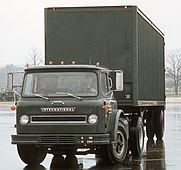
0 Response to "150 Years of International Harvester Online Read"
Post a Comment